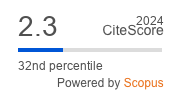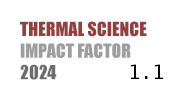THERMAL SCIENCE
International Scientific Journal
Thermal Science - Online First
online first only
Semantic segmentation for mapping agricultural waste sources: A vineyard case study for energy valorization via biogas production
ABSTRACT
Given the growing trend of increasing waste and diminishing resources, considerable efforts are being directed toward developing innovative methods for utilizing various types of waste as potential energy and material resources. Agriculture generates large quantities of waste, and inadequate management of this waste can cause severe environmental challenges. Transforming agricultural waste (AW) into biogas presents an excellent opportunity for its effective use; however, commercializing this process requires a comprehensive understanding of potential AW sources, primarily the types and quantities of waste generated. Consequently, this paper proposes a deep learning-based image segmentation approach for identifying potential AW sources using remote sensing images. The research examines the effectiveness of the DeepLabV3+ with various backbone networks for semantic segmentation with an emphasis on detecting vineyards as potential contributors to agricultural waste for biogas generation.
KEYWORDS
PAPER SUBMITTED: 2024-12-17
PAPER REVISED: 2025-01-31
PAPER ACCEPTED: 2025-02-05
PUBLISHED ONLINE: 2025-04-05
- European Commission, 2006. Thematic Strategy for Soil Protection (STS). COM (2006) 231
- Mönkäre, T.J., et. al., Characterization of fine fraction mined from two Finnish landfills, Waste Management, 47(Part A) (2016), pp. 34-39, doi.org/10.1016/j.wasman.2015.02.034
- Subramaniam, V., et. al., GHG analysis of the production of crude palm oil considering the conversion of agricultural wastes to by-products, Sustainable Production and Consumption, 28 (2021), pp.1552-1564, doi.org/10.1016/j.spc.2021.09.004
- Pavwelczyk, A., EU Policy and Legislation on recycling of organic wastes of agriculture, International Society for Animal Hygiene, (2005)
- Mohammed, M.A., et. al., Utilization of various agricultural waste materials in the treatment of Industrial wastewater containing Heavy metals: A Review, International Research Journal of Environment Sciences, 3(3) (2014), pp.62-71
- Lalić, D., et. al., Analysis of the opportunities and challenges for renewable energy market in the Western Balkan countries, Renewable and Sustainable Energy Reviews, 15(2011), 6, pp. 3187- 3195, doi.org/10.1016/j.rser.2011.04.011
- Clausi, D.A., An analysis of co-occurrence texture statistics as a function of grey level quantization, Canadian Journal of Remote Sensing, 28 (2002),1, doi: 10.5589/m02-004
- Barber, D.G., Ledrew, E.F., SAR Sea Ice Discrimination Using Texture Statistics: A Multivariate Approach, Photogrammetric Engineering and Remote Sensing, 57(1991)
- Pesaresi, M., Benediktsson, J.A., A new approach for the morphological segmentation of highresolution satellite imagery. IEEE Transactions on Geoscience and Remote Sensing, 39 (2001), 2, doi: 10.1109/36.905239
- Chen, T., et. al., Object-oriented landslide mapping using ZY-3 satellite imagery, random forest and mathematical morphology, for the Three-Gorges Reservoir, China, Remote Sens (Basel), 9 (2017), 4, doi: 10.3390/rs9040333
- Zhang, W., et. al., Object detection in high-resolution remote sensing images using rotation invariant parts-based model. IEEE Geoscience and Remote Sensing Letters, 11(2014), 1, doi:10.1109/LGRS.2013.2246538
- Cheng, G., et. al. Learning rotation-invariant convolutional neural networks for object detection in VHR optical remote sensing images. IEEE Transactions on Geoscience and Remote Sensing, 54 (2016), 12, doi: 10.1109/TGRS.2016.2601622 11
- Yokoya, N., Iwasaki, A., Object detection based on sparse representation and Hough voting for optical remote sensing imagery. IEEE Journal of Selected Topics in Applied Earth Observations and Remote Sensing, 8 (2015), 5,doi: 10.1109/TGRS.2016.2601622
- Sun, H., et. al., Automatic target detection in high-resolution remote sensing images using spatial sparse coding bag-of-words model, IEEE Geoscience and Remote Sensing Letters, 9 (2012), 1,doi: 10.1109/LGRS.2011.2161569
- Hamida, A., et. al., Deep learning for semantic segmentation of remote sensing images with rich spectral content, Proceedings of the IEEE International Geoscience and Remote Sensing Symposium, , Chennai, India, 2017, pp. 2569-2572
- Yun, K., et. al., Deep neural networks for pattern recognition, In Advances in Pattern Recognition Research, (2018), pp. 49-79
- Wu, J., Introduction to convolutional neural networks, Introduction to Convolutional Neural Networks, 2017
- Wang, P., et al., Understanding Convolution for Semantic Segmentation, Proceedings - 2018 IEEE Winter Conference on Applications of Computer Vision, (2018), doi:10.1109/WACV.2018.00163
- Guo, R., et al., Pixel-Wise Classification Method for High Resolution Remote Sensing Imagery Using Deep Neural Networks, ISPRS International Journal of Geo-Information, 7(2018), 3, pp. 110, doi: 10.3390/IJGI7030110
- Shelhamer, E., et al., Fully Convolutional Networks for Semantic Segmentation, IEEE Transactions on Pattern Analysis and Machine Intelligence, 39, (2017), 4, pp. 640-651, doi: 10.1109/TPAMI.2016.2572683
- Badrinarayanan, V., SegNet: a deep convolutional encoder-decoder architecture for image segmentation, IEEE Transactions on Pattern Analysis and Machine Intelligence, 39, (2017), ,pp. 2481-2495
- Simonyan, K., Zisserman, A., Very deep convolutional networks for large-scale image recognition, arXiv:1409.1556, 2014
- Wang, W., Kang, Y., Liu, G., & Wang, X. (2022). SCU-Net: Semantic Segmentation Network for Learning Channel Information on Remote Sensing Images. Computational Intelligence and Neuroscience, 2022
- W. Wang, H. Liu, J. Li, H. Nie, and X. Wang, "Using CFW-net deep learning models for Xray images to detect COVID-19 patients," International Journal of Computational Intelligence Systems, vol. 14, no. 1, pp. 199-207, 2020
- O. Ronneberger, P. Fischer, and T. Brox, "U-Net: convolutional networks for biomedical image segmentation," in Proceedings of the International Conference on Medical Image Computing and Computer-Assisted Intervention, p. 3, 2015
- L. L.-C. Chen, G. Papandreou, I. Kokkinos, K. Murphy, and A. L. Yuille, "Semantic image segmentation with deep convolutional nets and fully connected crfs," in ICLR, 2015
- L.-C. Chen, G. Papandreou, I. Kokkinos, K. Murphy, and A. L. Yuille, "DeepLab: semantic image segmentation with deep convolutional nets, Atrous convolution, and fully connected CRFs," IEEE Transactions on Pattern Analysis and Machine Intelligence, vol. 40, no. 4, pp. 834-848, 2018. 12
- L. C. Chen, G. Papandreou, F. Schroff, and H. Adam, "Rethinking Atrous convolution for semantic image segmentation," arXiv:1706.05587, 20
- L.-C. Chen, Y. Zhu, G. Papandreou, F. Schroff, and H. Adam, "Encoder-decoder with Atrous separable convolution for semantic image Segmentation," in Proceedings of the European Conference on Computer Vision (ECCV), pp. 833-851, Springer, Munich, Germany, September 2018
- S. Das, A. A. Fime, N. Siddique and M. M. A. Hashem, "Estimation of Road Boundary for Intelligent Vehicles Based on DeepLabV3+ Architecture," in IEEE Access, vol. 9, pp. 121060- 121075, 2021, doi: 10.1109/ACCESS.2021.3107353
- Zhang, X., Fu, L., Karkee, M., Whiting, M. D., & Zhang, Q. (2019). Canopy segmentation using ResNet for mechanical harvesting of apples. IFAC-PapersOnLine, 52(30), 300-305
- Home | Statistical Office of the Republic of Serbia." www.stat.gov.rs/en-US/
- K. He, X. Zhang, S. Ren, and J. Sun, "Deep residual learning for image recognition," in Proceedings of the IEEE Computer Society Conference on Computer Vision and Pattern Recognition, 2016, vol. 2016-December. doi: 10.1109/CVPR.2016.90
- Sandler, M., Howard, A., Zhu, M., Zhmoginov, A., & Chen, L. C. (2018). Mobilenetv2: Inverted residuals and linear bottlenecks. In Proceedings of the IEEE conference on computer vision and pattern recognition (pp. 4510-4520)
- Chollet, F. (2017). Xception: Deep learning with depthwise separable convolutions. In Proceedings of the IEEE conference on computer vision and pattern recognition (p. 1251-1258)
- Szegedy, C., Ioffe, S., Vanhoucke, V., & Alemi, A. A. (2017, February). Inception-v4, inception-resnet and the impact of residual connections on learning. In the Thirty-first AAAI conference on artificial intelligence
- X. Zhang, L. Fu, M. Karkee, M. Whiting, and Q. Zhang, "Canopy Segmentation Using ResNet for Mechanical Harvesting of Apples," in IFAC-PapersOnLine, 2019, vol. 52, no. 30. doi: 10.1016/j.ifacol.2019.12.550
- B. Neupane, T. Horanont, and J. Aryal, "Deep learning-based semantic segmentation of urban features in satellite images: A review and meta-analysis," Remote Sensing, vol. 13, no. 4. 2021. doi: 10.3390/rs13040808
- ImageNet. www.image-net.org
- E. Fernandez-Moral, R. Martins, D. Wolf, and P. Rives, "A New Metric for Evaluating Semantic Segmentation: Leveraging Global and Contour Accuracy," in IEEE Intelligent Vehicles Symposium, Proceedings, 2018, vol. 2018-June. doi: 10.1109/IVS.2018.8500497
- D. Pathak, E. Shelhamer, J. Long, and T. Darrell, "Fully Convolutional Multi-Class Multiple Instance Learning," 3rd International Conference on Learning Representations, ICLR 2015 - Workshop Track Proceedings, Dec. 2014, doi: 10.48550/arxiv.1412.7144
- G. Csurka, D. Larlus, and F. Perronnin, "What is a good evaluation measure for semantic segmentation?," undefined, 2013, doi: 10.5244/C.27.32
- A. J. Momčilović, G. M. Stefanović, P. M. Rajković, N. V. Stojković, B. B. Milutinović, and M. P. Ivanović, "The organic waste fractions ratio optimization in the anaerobic co-digestion process for the increase of biogas yield," Thermal Science, vol. 22, Supplement 5, 2018

